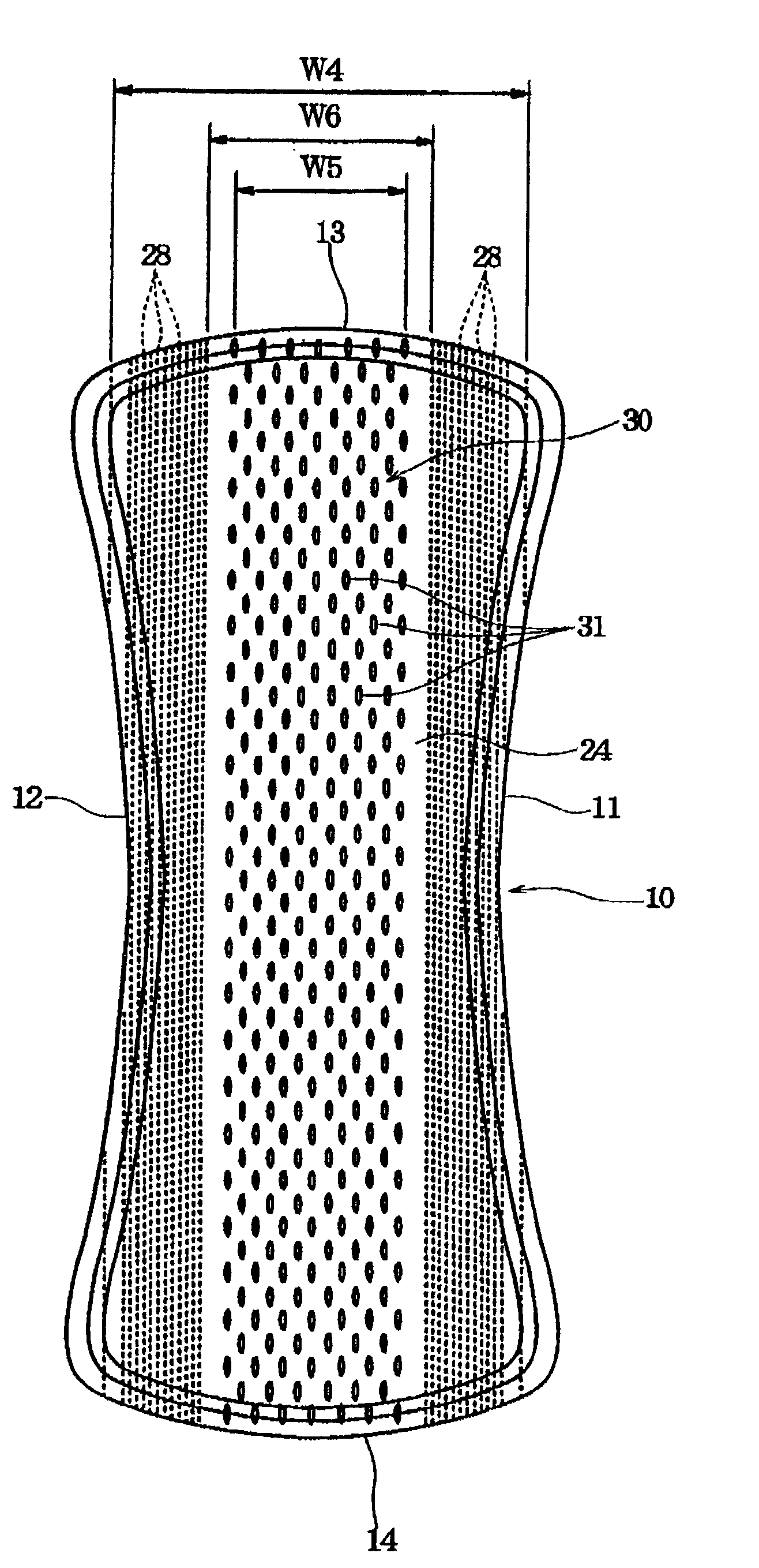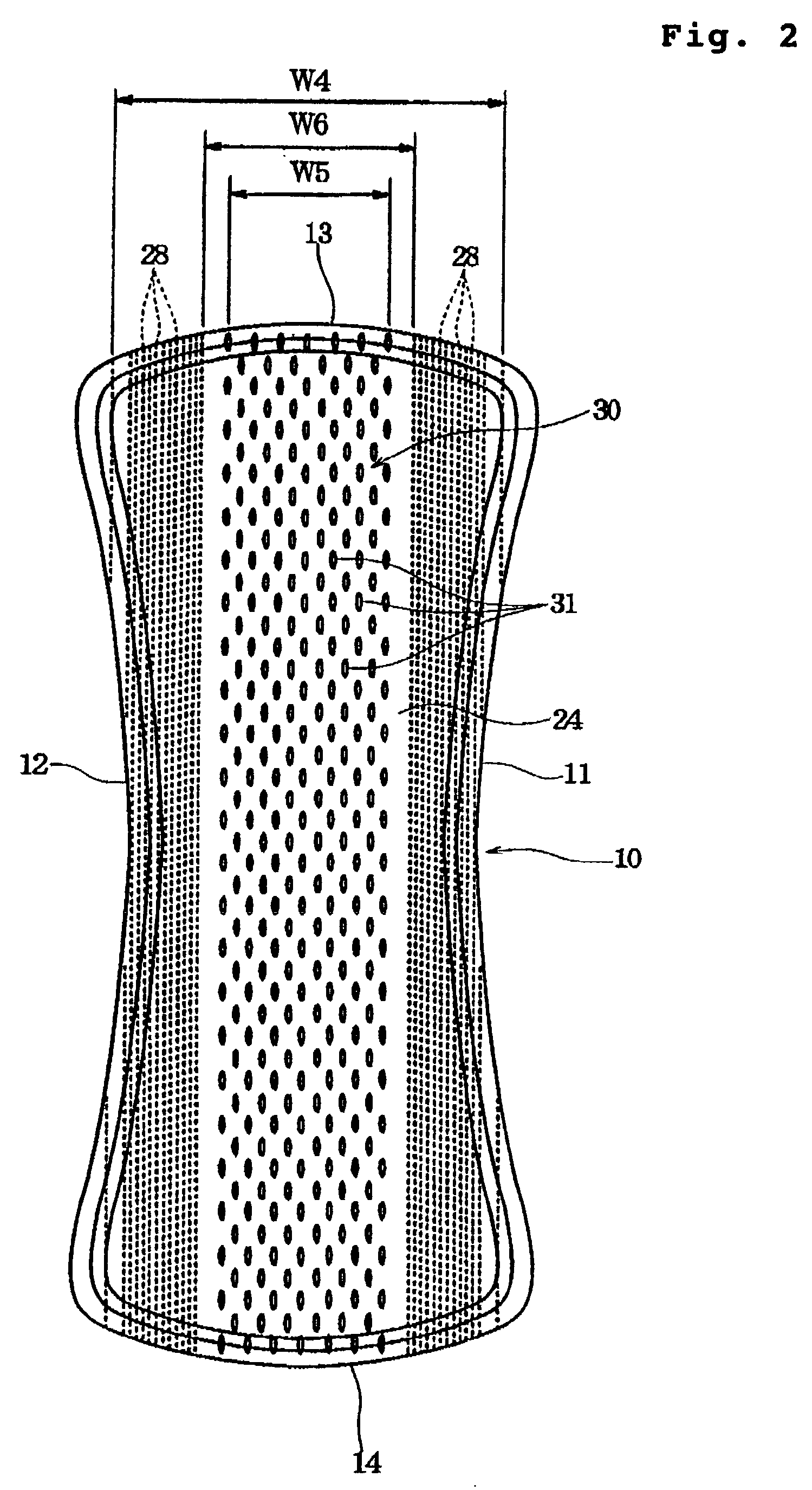[0019] In the absorbent article of the present invention, the topsheet, the intermediate sheet underlying the topsheet, and the liquid absorbent layer underlying the intermediate sheet are all hydrophilic. A discharged liquid such as
vaginal discharge locally given to the
central region is attracted into the inside of the absorbent article due to
capillary action of the plurality of liquid passage holes continuously extending from the topsheet to the intermediate sheet in the central region, diffused to surroundings through the intermediate sheet, and then absorbed by the liquid absorbent layer underlying the intermediate sheet. Accordingly, even if the liquid absorbent layer, intermediate sheet and topsheet are made thin to provide a thin structure as a whole, the locally given liquid can be absorbed while being diffused. Therefore, the absorbent article of the present invention can be made thin and used for a long time.
[0022] Preferably, at least one of the topsheet and the intermediate sheet is formed of through-air bonded
nonwoven fabric, of which synthetic fibers are thermal bonded to each other with hot air. If through-air bonded
nonwoven fabric is used, a soft contact feel can be provided to the
skin of a wearer during wear. In addition, since the distance between adjacent fibers is relatively large in through-air bonded nonwoven fabric, the synthetic fibers are hardly
cut at the holes during formation of the liquid passage holes, so that the shape of the holes can be maintained.
[0023] It is also possible that fibers forming the topsheet are coated with an initial hydrophilic agent and fibers forming the intermediate sheet are coated with a durable hydrophilic agent. In the case where the fibers forming the intermediate sheet is coated with the durable hydrophilic agent, hydrophilicity of the intermediate sheet can be maintained for a long time, so that the liquid diffused in the intermediate sheet can permeate the liquid absorbent layer for a long time. In this case, it is preferred that the intermediate sheet includes a bottom layer adjacent to the liquid absorbent layer and a top layer adjacent to the topsheet, and fibers forming the bottom layer are coated with the durable hydrophilic agent and fibers forming the top layer are coated with the initial hydrophilic agent. In the case where the fibers forming the bottom layer of the intermediate sheet are coated with the durable hydrophilic agent, the bottom layer of the intermediate sheet can remain hydrophilic for a long time, so that the liquid diffused in the intermediate sheet can be readily given to the liquid absorbent layer. That is, it is preferred that hydrophilicity of the bottom layer of the intermediate sheet is higher than hydrophilicity of the top layer of the intermediate sheet, and hydrophilicity of the topsheet is equal to or higher than the hydrophilicity of the bottom layer of the intermediate sheet. With the hydrophilicities being set as above, the liquid given to the topsheet passes through the top layer of the intermediate sheet while being attracted to the bottom layer, and thereafter, it readily permeates the liquid absorbent layer. Accordingly, the locally given liquid can be readily diffused and absorbed.
[0024] Preferably, the topsheet and the intermediate sheet are bonded through an adhesive layer which is applied in a plurality of strips extending longitudinally of the absorbent article and spaced apart from each other transversely of the absorbent article. In the case where the adhesive layer is applied in such plurality of strips extending longitudinally of the absorbent article, the adhesive layer can exhibit a function of diffusing the liquid longitudinally of the absorbent article. In this case, if the adhesive layer is provided in regions transversely outside the central region having the liquid passage holes formed therein, the adhesive layer does not prevent
permeation of the liquid through the liquid passage holes. In addition, since the surface for contacting the
skin of a wearer is not stiffened in the central region, it feels comfortable to wear and hardly has a bad influence upon the skin.
[0028] The present invention will be more effective if the absorbent article is constructed as a so-called long-size type having an entire length equal to or larger than 160 mm. In the present invention, the liquid given to the topsheet can be absorbed while being diffused in the central region longitudinally of the absorbent article, and then, likewise diffused through the intermediate sheet longitudinally of the absorbent article for absorption by the liquid absorbent layer. Therefore, if the absorbent article is of the long-size type, its length can be effectively utilized.
 Login to View More
Login to View More  Login to View More
Login to View More 


